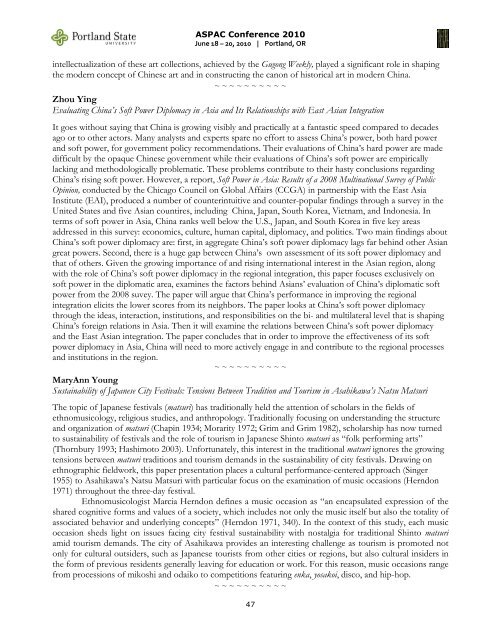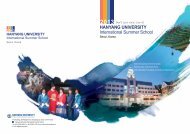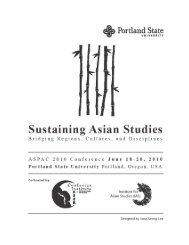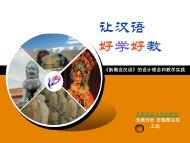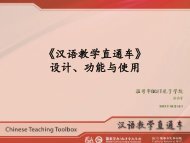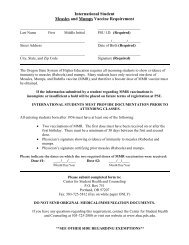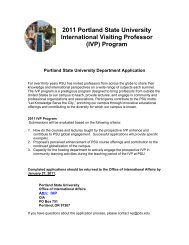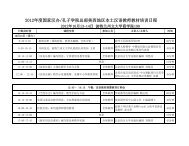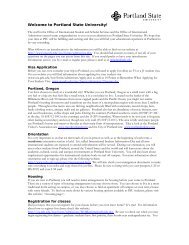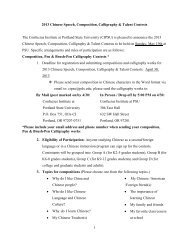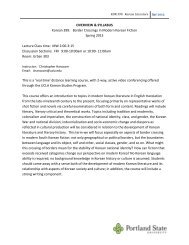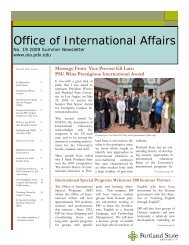ABSTRACTS - oia - Portland State University
ABSTRACTS - oia - Portland State University
ABSTRACTS - oia - Portland State University
You also want an ePaper? Increase the reach of your titles
YUMPU automatically turns print PDFs into web optimized ePapers that Google loves.
ASPAC Conference 2010<br />
June 18 – 20, 2010 | <strong>Portland</strong>, OR<br />
intellectualization of these art collections, achieved by the Gugong Weekly, played a significant role in shaping<br />
the modern concept of Chinese art and in constructing the canon of historical art in modern China.<br />
~ ~ ~ ~ ~ ~ ~ ~ ~ ~<br />
Zhou Ying<br />
Evaluating China’s Soft Power Diplomacy in Asia and Its Relationships with East Asian Integration<br />
It goes without saying that China is growing visibly and practically at a fantastic speed compared to decades<br />
ago or to other actors. Many analysts and experts spare no effort to assess China’s power, both hard power<br />
and soft power, for government policy recommendations. Their evaluations of China’s hard power are made<br />
difficult by the opaque Chinese government while their evaluations of China’s soft power are empirically<br />
lacking and methodologically problematic. These problems contribute to their hasty conclusions regarding<br />
China’s rising soft power. However, a report, Soft Power in Asia: Results of a 2008 Multinational Survey of Public<br />
Opinion, conducted by the Chicago Council on Global Affairs (CCGA) in partnership with the East Asia<br />
Institute (EAI), produced a number of counterintuitive and counter-popular findings through a survey in the<br />
United <strong>State</strong>s and five Asian countires, including China, Japan, South Korea, Vietnam, and Indonesia. In<br />
terms of soft power in Asia, China ranks well below the U.S., Japan, and South Korea in five key areas<br />
addressed in this survey: economics, culture, human capital, diplomacy, and politics. Two main findings about<br />
China’s soft power diplomacy are: first, in aggregate China’s soft power diplomacy lags far behind other Asian<br />
great powers. Second, there is a huge gap between China’s own assessment of its soft power diplomacy and<br />
that of others. Given the growing importance of and rising international interest in the Asian region, along<br />
with the role of China’s soft power diplomacy in the regional integration, this paper focuses exclusively on<br />
soft power in the diplomatic area, examines the factors behind Asians’ evaluation of China’s diplomatic soft<br />
power from the 2008 suvey. The paper will argue that China’s performance in improving the regional<br />
integration elicits the lower scores from its neighbors. The paper looks at China’s soft power diplomacy<br />
through the ideas, interaction, institutions, and responsibilities on the bi- and multilateral level that is shaping<br />
China’s foreign relations in Asia. Then it will examine the relations between China’s soft power diplomacy<br />
and the East Asian integration. The paper concludes that in order to improve the effectiveness of its soft<br />
power diplomacy in Asia, China will need to more actively engage in and contribute to the regional processes<br />
and institutions in the region.<br />
~ ~ ~ ~ ~ ~ ~ ~ ~ ~<br />
MaryAnn Young<br />
Sustainability of Japanese City Festivals: Tensions Between Tradition and Tourism in Asahikawa’s Natsu Matsuri<br />
The topic of Japanese festivals (matsuri) has traditionally held the attention of scholars in the fields of<br />
ethnomusicology, religious studies, and anthropology. Traditionally focusing on understanding the structure<br />
and organization of matsuri (Chapin 1934; Morarity 1972; Grim and Grim 1982), scholarship has now turned<br />
to sustainability of festivals and the role of tourism in Japanese Shinto matsuri as “folk performing arts”<br />
(Thornbury 1993; Hashimoto 2003). Unfortunately, this interest in the traditional matsuri ignores the growing<br />
tensions between matsuri traditions and tourism demands in the sustainability of city festivals. Drawing on<br />
ethnographic fieldwork, this paper presentation places a cultural performance-centered approach (Singer<br />
1955) to Asahikawa’s Natsu Matsuri with particular focus on the examination of music occasions (Herndon<br />
1971) throughout the three-day festival.<br />
Ethnomusicologist Marcia Herndon defines a music occasion as “an encapsulated expression of the<br />
shared cognitive forms and values of a society, which includes not only the music itself but also the totality of<br />
associated behavior and underlying concepts” (Herndon 1971, 340). In the context of this study, each music<br />
occasion sheds light on issues facing city festival sustainability with nostalgia for traditional Shinto matsuri<br />
amid tourism demands. The city of Asahikawa provides an interesting challenge as tourism is promoted not<br />
only for cultural outsiders, such as Japanese tourists from other cities or regions, but also cultural insiders in<br />
the form of previous residents generally leaving for education or work. For this reason, music occasions range<br />
from processions of mikoshi and odaiko to competitions featuring enka, yosakoi, disco, and hip-hop.<br />
~ ~ ~ ~ ~ ~ ~ ~ ~ ~<br />
47


